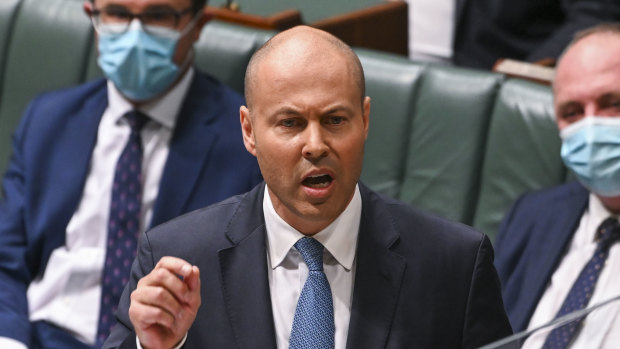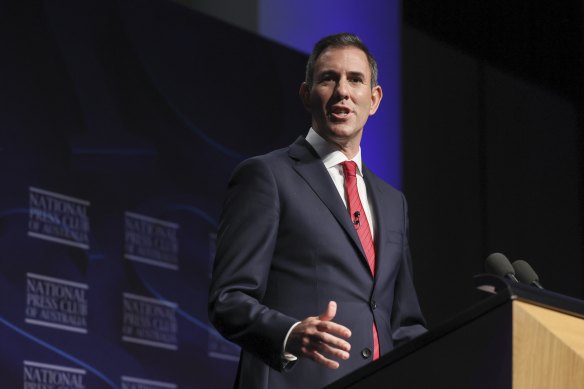This was published 3 years ago
Budget bleeds red ink as IMF says now is time to start fiscal repair
By Shane Wright and Rachel Clun
Australia has suffered one of the largest budget deteriorations in the developed world and one of the biggest increases in debt, and the International Monetary Fund is warning budget repair has to start soon.
As the federal Treasury and Finance Departments found the cost of servicing the nation’s record debt had climbed by billions of dollars since the budget was released just a fortnight ago, the IMF released new data showing the increased financial strain on the nation’s finances.

Treasurer Josh Frydenberg hands down last month’s budget. It is forecasting the third and fourth-largest budget deficits in Australian fiscal history.Credit: Getty
Both the Coalition and Labor are going to the May 21 election promising little in the way of repair to the budget, which has recorded its three largest deficits in history since the advent of the pandemic recession.
Labor has promised, but not yet released, policies to raise extra revenue from multinational businesses while in last month’s budget the Coalition extended funding for the Tax Office’s targeting of high net wealth individuals. Neither has outlined any substantial spending cuts.
The IMF, in a report on the global fiscal outlook released overnight, said there was growing pressure on the budgets of most governments.
Of 34 developed nations tracked by the fund, Australia will have the eighth-largest structural deficit next financial year at 3.6 per cent of GDP. Measures of the structural budget bottom line strip out one-off or unusual flows of income or spending.
Nations such as South Korea, New Zealand, Canada, Britain, Italy, Germany and France are all expected to have smaller structural deficits than Australia in 2023.
Australia has also suffered one of the largest increases in gross debt in the developed world.
When the Coalition came to power in 2013, Australia’s gross debt was 30.5 per cent of GDP. By next year, it will have more than doubled to 62.5 per cent. Last week, it hit a record $889 billion.
Australia’s gross debt level is still well short of comparable nations such as Canada (98.5 per cent), Britain (92.6 per cent), the United States (124 per cent) and Spain (116.4 per cent). But in terms of increase, it is one of the largest in the developed world.

Shadow treasurer Jim Chalmers delivering his budget reply speech. Neither he nor Josh Frydenberg have outlined ways to reduce the nation’s budget deficits.Credit: Alex Ellinghausen
The fund’s fiscal affairs department director, Vitor Gaspar, said there were growing risks facing countries that had increased their debt levels to deal with COVID-19.
He said nations less exposed to the events in Ukraine and where central banks are lifting interest rates, such as Australia, should start “normalising” their fiscal policy.
“Treasuries in advanced economies must heed rising inflation. For the past two decades, they have benefited from declining debt service costs, stemming from trends both in nominal interest rates and neutral real interest rates,” he said.
“It is true that inflation surprises contribute to lower debt ratios but in a regime of permanently
high and volatile inflation, the attractiveness of sovereign bonds is undermined, making it harder to sustain elevated levels of debt.”
Treasury and Finance used their pre-election economic and fiscal outlook, which updates the budget without government intervention, to confirm this year’s budget deficit is on track to be $79.8 billion, the third-largest in history, followed by a $77.9 billion deficit in 2022-23.
Long term, without changes in policies, the budget will remain in deficit for the rest of the decade and beyond.
Gross debt is forecast to reach a record $906 billion by the end of this financial year, grow to $977 billion in 2022-23 and top $1 trillion the following year.
The departments confirmed that without tax cuts, which would increase budget deficits, the Coalition will breach its own tax cap of 23.9 per cent of GDP by the end of this decade.
Payments as a share of GDP, currently 27.2 per cent, are expected to edge down over coming years but remain at 26.5 per cent in 2032-33.
Total receipts are forecast to reach 25.8 per cent of GDP by 2032-33. But the Coalition’s tax cap would require a reduction in taxes. Even without the cap, the budget deficit would be about 0.7 per cent of GDP.
While the two departments did not change the budget forecasts, they noted that whoever wins the election is likely to face higher borrowing costs.
They found if the lift in rates is sustained, interest payments as a share of GDP are likely to be 0.1 per cent of GDP or $2.5 billion higher in 2025-26. Gross debt by the end of 2026 would be 0.5 percentage points higher or almost $13 billion.
The departments also revealed the next parliament will have to pass $54.3 billion worth of spending measures.
This includes measures promised before this year’s budget that will cost the bottom line $19.7 billion to 2025-26, and $34.6 billion that were included in the March 29 budget.
“Where legislation is not passed by the scheduled commencement date, is passed with amendments to the original decision, or is rejected, there is a risk of a variation to the fiscal position outlined in the PEFO,” the departments warned.